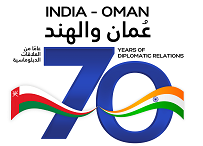Menu
Bilateral
Trade & Commerce
Labour & Community Welfare
Consular
Education
Culture & Tourism
Media Center
What's New
Speech at the inauguration of Vastram - Splendid World of Indian Textiles
Back | PrintExcellencies, distinguished guests, friends from media, ladies and gentlemen, Good Evening
I extend a warm welcome to you all and thank you for joining us this evening at the launch of "Vastram- Splendid World of Indian Textiles". Today is a local holiday and your presence this evening is highly appreciated. I want to thank the Indian Council of Cultural Relations for sending this collection to Muscat. I also thank the Government of Oman for facilitating and enabling this display. I am grateful to Lulu Group for not only providing the venue but also organising cultural performances and giving publicity to this Exhibition. Their team worked very closely with the Embassy to make this exhibition possible. I want to convey my deep appreciation to the community organisations for their contribution. I hope our collective efforts will be successful in persuading thousands of visitors who come to the Mall to also visit this Exhibition.
It is believed that it was in Indian subcontinent 8000 years ago that for the first time cotton yarn was spun and woven into a garment. Recent archaeological discoveries in Harappa suggest that sericulture, employing wild silk threads from native silkworm species, existed in South Asia during the time of Indus Valley Civilization dating between 2500 BC and 2000 BC. Textiles have since been an integral part of the development of Indias civilisation, including its art, culture and traditions. It was the evolution of textile industry on river banks that formed the basis of the development of Indias economy and population.
It is not surprising that, given the centrality of textiles in Indias history and culture, Mahatma Gandhi made the revival of Indias cotton industry, through encouraging household spinning of cotton yarn and weaving of khadi, his key goal, which soon became a potent symbol of self-reliance. The industrialization in India began with setting up of textile mills in various parts of India and the textile industry today is the second largest employment generating sector in India. It offers direct employment to over 35 million persons besides indirect employment to millions more. The present Government has attached a huge importance to popularizing use of khadi, a hand woven fabric made from cotton or silk yarn, in India and abroad. It has also taken initiatives to preserve and promote Indias old textile traditions, including the handloom and cottage textiles, which are a major source of employment in rural India.
There is evidence that Indian textiles were being exported as early as 5th century BC. Indian textiles were a principal commodity of trade in the pre- industrial age and were prized for their fineness in weave, brilliance in color, rich variety in designs and a dyeing technology which achieved a brightness of color unrivalled in the world. From the 16th century, Indian cotton textiles achieved global reach through trade dominating the worlds textile market. During the late 17th and 18th century there were large exports of Indian cotton textiles to the western countries. After going through a period of decline in 19th and 20th Centuries during the colonial rule, Indian textiles have, since independence, regained their status as the textile of choice throughout the world.
Indias composite culture has evolved by absorbing new influences from abroad and making them her own. We celebrate our diversity while taking pride in the underlying unity. Indias rich diversity is evident in Indias hugely varied textile traditions - in our sarees, turbans, dress-materials, linen etc. There is an immense variety in Indian textiles in terms of the materials used - cotton, silk, wool, jute, synthetic yarn etc. - and the processes used to make them like spinning, weaving, dyeing, printing and embroidering. Apart from regional diversities in terms of use of materials, colours and patterns, textiles are also made for different purposes and usage.
The purpose of Vastram is to showcase this diversity of Indian textiles coming from different regions of India to the friendly people of Oman. Oman is a maritime neighbour of India and people to people relations and exchanges, including trade, have been a key enabling factor in evolution of Indias historical ties with Oman. People of Oman have been aware of Indias textiles and textile making traditions. As the tourism between the two countries is growing, there is a growing mutual awareness of diverse cultures of India and Oman. I hope Vastram will go a long way in creating a better and deeper understanding in Oman of Indias diverse textile traditions. Hopefully, it will also lead to better awareness of Indian culture and more trade in textiles.
To conclude, I thank you all again for joining this ceremony and hope you enjoy the Display. I wish you a very good evening and a good week-end. Thank you.













